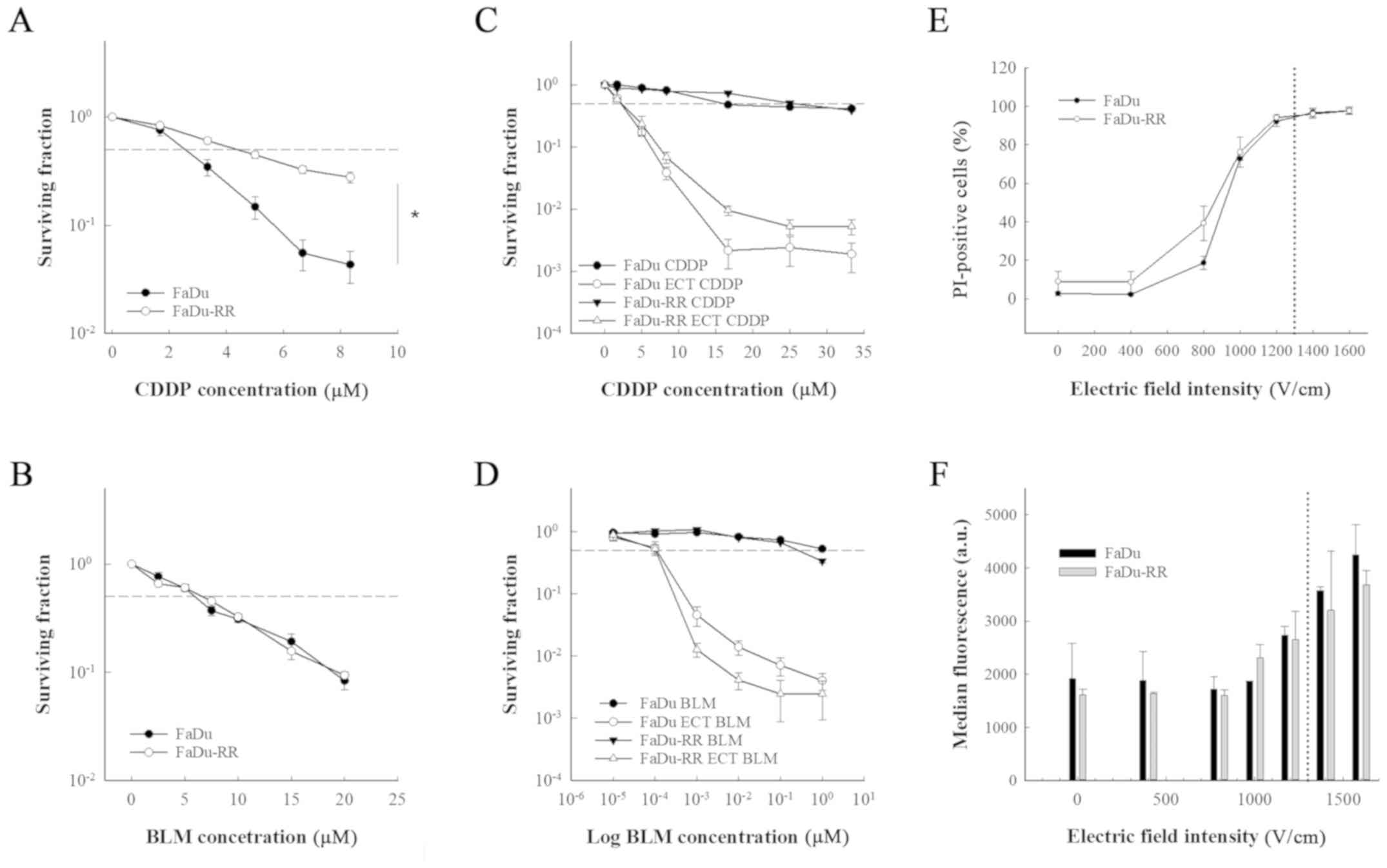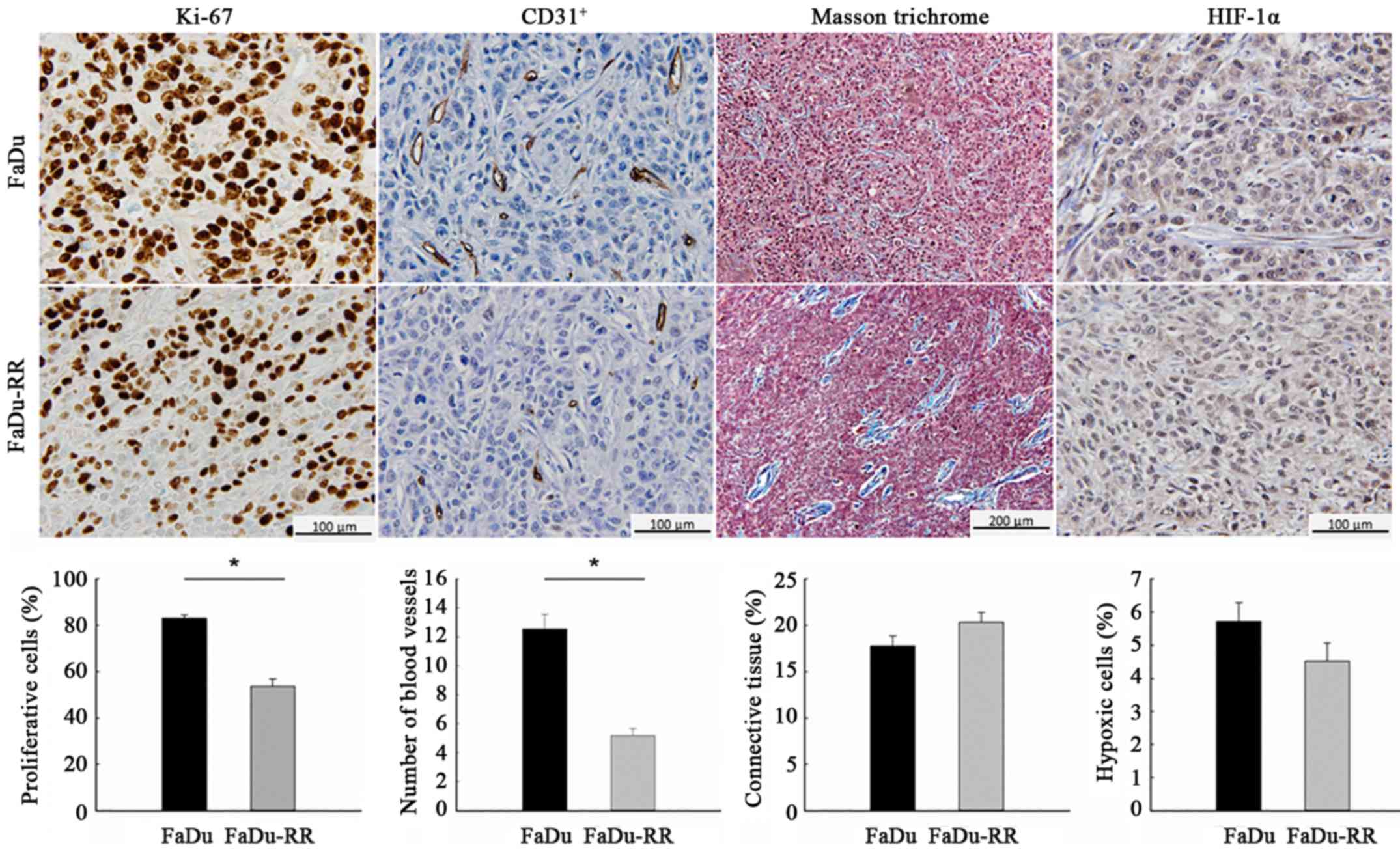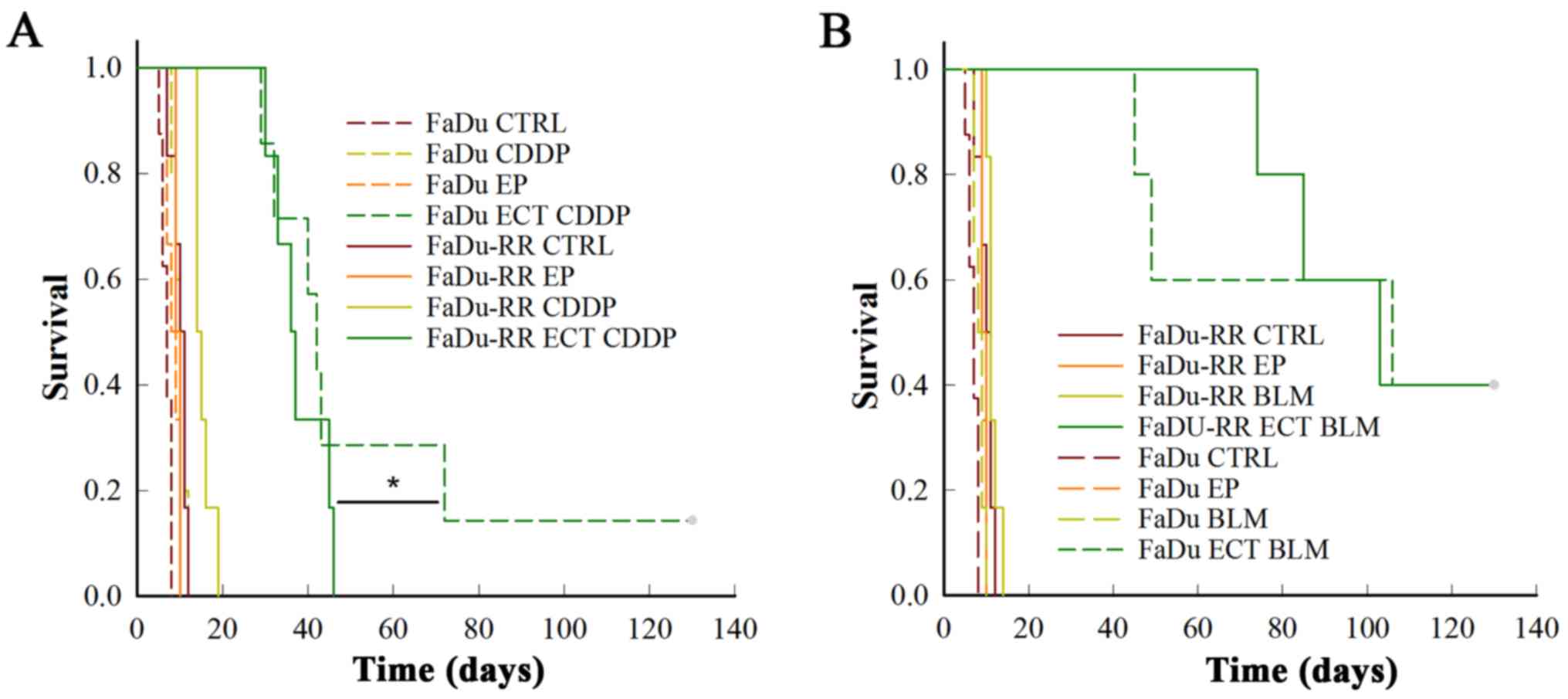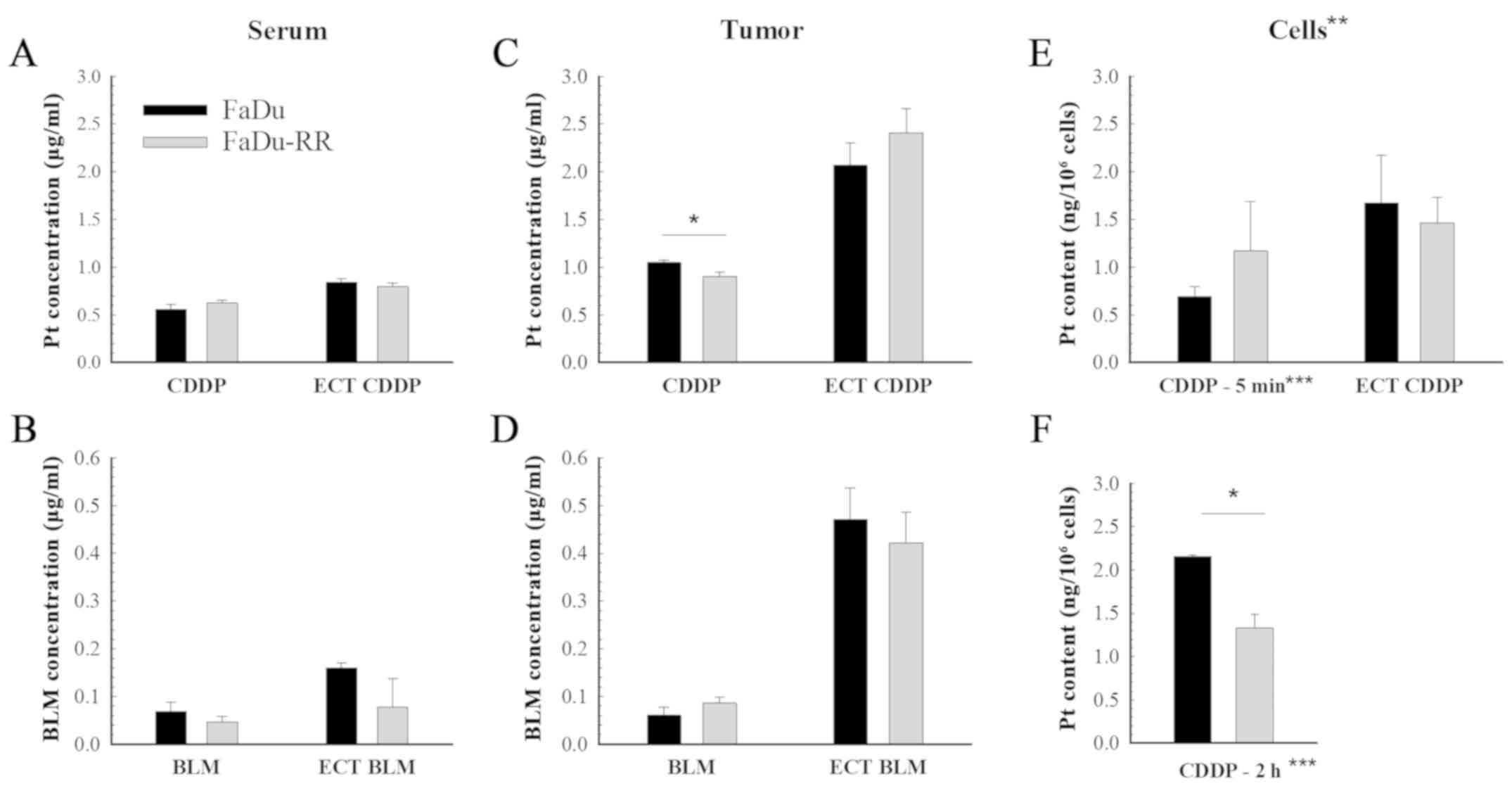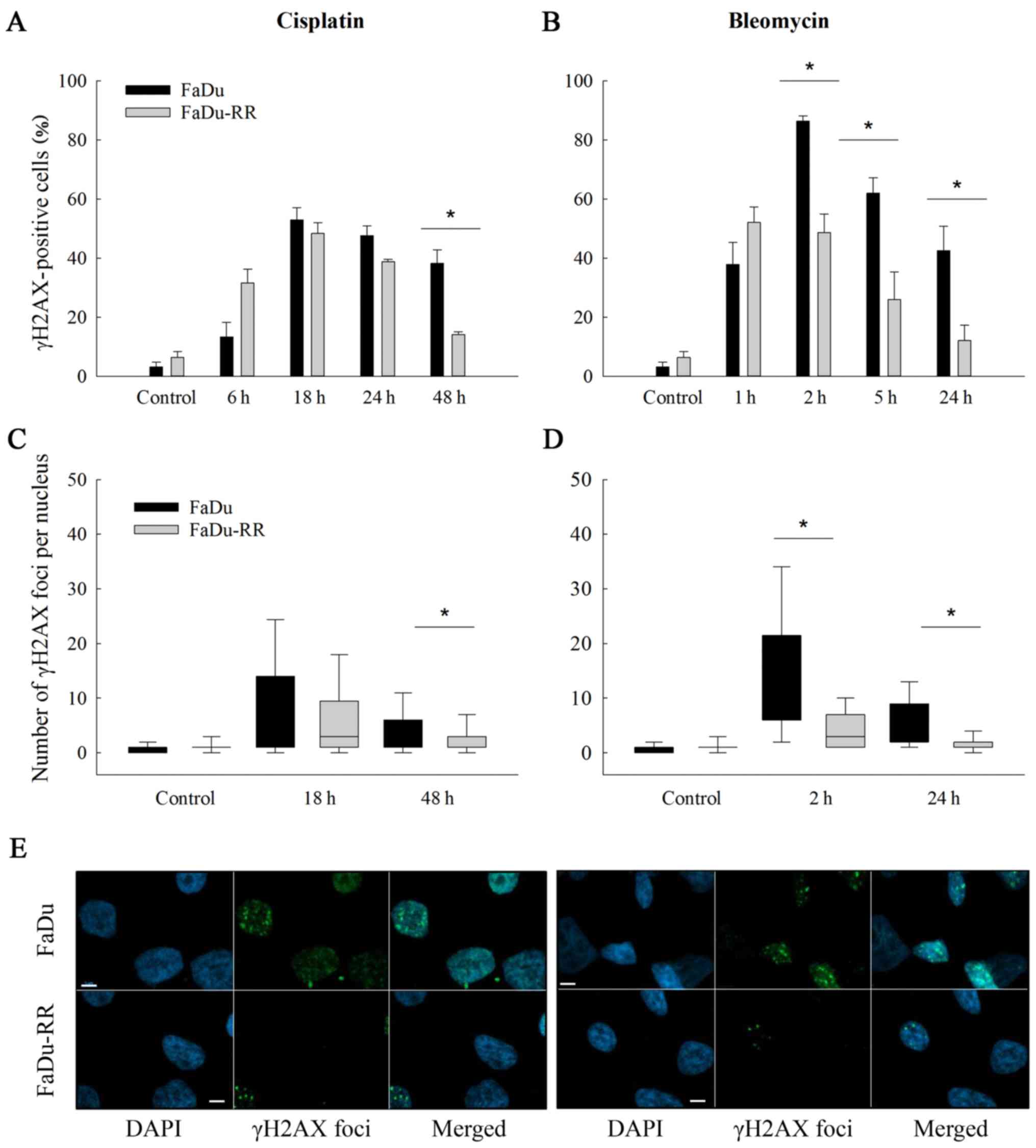|
1
|
Yarmush ML, Golberg A, Serša G, Kotnik T
and Miklavčič D: Electroporation-based technologies for medicine:
Principles, applications and challenges. Annu Rev Biomed Eng.
16:295–320. 2014. View Article : Google Scholar : PubMed/NCBI
|
|
2
|
Mir LM, Orlowski S, Belehradek J Jr,
Teissie J, Rols PM, Sersa G, Miklavcic D, Gilbert R and Heller R:
Biomedical applications of electric pulses with special emphasis on
antitumor electrochemotherapy. Bioelectrochem Bioenerg. 38:203–207.
1995. View Article : Google Scholar
|
|
3
|
Sersa G, Bosnjak M, Cemazar M and Heller
R: Preclinical studies on electrochemotherapy. Handbook of
Electroporation. Miklavčič D: Springer International Publishing;
Cham, Switzerland: pp. 2153–2169. 2017
|
|
4
|
Calvet CY, Famin D, André FM and Mir LM:
Electrochemotherapy with bleomycin induces hallmarks of immunogenic
cell death in murine colon cancer cells. Oncoimmunology.
3:e281312014. View Article : Google Scholar : PubMed/NCBI
|
|
5
|
Di Gennaro P, Gerlini G, Urso C, Sestini
S, Brandani P, Pimpinelli N and Borgognoni L:
CD4+FOXP3+ T regulatory cells decrease and
CD3+CD8+ T cells recruitment in TILs from
melanoma metastases after electrochemotherapy. Clin Exp Metastasis.
33:787–798. 2016. View Article : Google Scholar : PubMed/NCBI
|
|
6
|
Sersa G, Jarm T, Kotnik T, Coer A,
Podkrajsek M, Sentjurc M, Miklavcic D, Kadivec M, Kranjc S, Secerov
A, et al: Vascular disrupting action of electroporation and
electrochemotherapy with bleomycin in murine sarcoma. Br J Cancer.
98:388–398. 2008. View Article : Google Scholar : PubMed/NCBI
|
|
7
|
Mali B, Jarm T, Snoj M, Sersa G and
Miklavcic D: Antitumor effectiveness of electrochemotherapy: A
systematic review and meta-analysis. Eur J Surg Oncol. 39:4–16.
2013. View Article : Google Scholar : PubMed/NCBI
|
|
8
|
Bertino G, Sersa G, De Terlizzi F, Occhini
A, Plaschke CC, Groselj A, Langdon C, Grau JJ, McCaul JA, Heuveling
D, et al: European research on electrochemotherapy in head and neck
cancer (EURECA) project: Results of the treatment of skin cancer.
Eur J Cancer. 63:41–52. 2016. View Article : Google Scholar : PubMed/NCBI
|
|
9
|
Plaschke CC, Bertino G, McCaul JA, Grau
JJ, de Bree R, Sersa G, Occhini A, Groselj A, Langdon C, Heuveling
DA, et al: European Research on Electrochemotherapy in Head and
Neck Cancer (EURECA) project: Results from the treatment of mucosal
cancers. Eur J Cancer. 87:172–181. 2017. View Article : Google Scholar : PubMed/NCBI
|
|
10
|
Spratt DE, Gordon Spratt EA, Wu S, DeRosa
A, Lee NY, Lacouture ME and Barker CA: Efficacy of skin-directed
therapy for cutaneous metastases from advanced cancer: A
meta-analysis. J Clin Oncol. 32:3144–3155. 2014. View Article : Google Scholar : PubMed/NCBI
|
|
11
|
Mevio N, Bertino G, Occhini A, Scelsi D,
Tagliabue M, Mura F and Benazzo M: Electrochemotherapy for the
treatment of recurrent head and neck cancers: Preliminary results.
Tumori. 98:308–313. 2012. View Article : Google Scholar : PubMed/NCBI
|
|
12
|
Groselj A, Kos B, Cemazar M, Urbancic J,
Kragelj G, Bosnjak M, Veberic B, Strojan P, Miklavcic D and Sersa
G: Coupling treatment planning with navigation system: A new
technological approach in treatment of head and neck tumors by
electrochemotherapy. Biomed Eng Online. 14 Suppl 3:S22015.
View Article : Google Scholar : PubMed/NCBI
|
|
13
|
Seccia V, Muscatello L, Dallan I,
Bajraktari A, Briganti T, Ursino S, Galli L, Falcone A and
Sellari-Franceschini S: Electrochemotherapy and its controversial
results in patients with head and neck cancer. Anticancer Res.
34:967–972. 2014.PubMed/NCBI
|
|
14
|
De Virgilio A, Ralli M, Longo L, Mancini
P, Attanasio G, Atturo F, De Vincentiis M and Greco A:
Electrochemotherapy in head and neck cancer: A review of an
emerging cancer treatment (Review). Oncol Lett. 16:3415–3423.
2018.PubMed/NCBI
|
|
15
|
Landström F, Ivarsson M, Von Sydow AK,
Magnuson A, Von Beckerath M and Möller C:
Electrochemotherapy-evidence for cell-type selectivity in vitro.
Anticancer Res. 35:5813–5820. 2015.PubMed/NCBI
|
|
16
|
Frandsen SK and Gehl J: A review on
differences in effects on normal and malignant cells and tissues to
electroporation-based therapies: A focus on calcium
electroporation. Technol Cancer Res Treat. 17:1533033818788072018.
View Article : Google Scholar
|
|
17
|
Plaschke CC, Gothelf A, Gehl J and Wessel
I: Electrochemotherapy of mucosal head and neck tumors: A
systematic review. Acta Oncol. 55:1266–1272. 2016. View Article : Google Scholar : PubMed/NCBI
|
|
18
|
Mali B, Miklavcic D, Campana LG, Cemazar
M, Sersa G, Snoj M and Jarm T: Tumor size and effectiveness of
electrochemotherapy. Radiol Oncol. 47:32–41. 2013. View Article : Google Scholar : PubMed/NCBI
|
|
19
|
Kunte C, Letulé V, Gehl J, Dahlstroem K,
Curatolo P, Rotunno P, Muir T, Occhini A, Bertino G, Powell B, et
al: Electrochemotherapy in the treatment of metastatic malignant
melanoma: A prospective cohort study by InspECT. Br J Dermatol.
176:1475–1485. 2017. View Article : Google Scholar : PubMed/NCBI
|
|
20
|
Campana LG, Mali B, Sersa G, Valpione S,
Giorgi CA, Strojan P, Miklavcic D and Rossi CR: Electrochemotherapy
in non-melanoma head and neck cancers: A retrospective analysis of
the treated cases. Br J Oral Maxillofac Surg. 52:957–964. 2014.
View Article : Google Scholar : PubMed/NCBI
|
|
21
|
Campana LG, Testori A, Curatolo P,
Quaglino P, Mocellin S, Framarini M, Borgognoni L, Ascierto PA,
Mozzillo N, Guida M, et al: Treatment efficacy with
electrochemotherapy: A multi-institutional prospective
observational study on 376 patients with superficial tumors. Eur J
Surg Oncol. 42:1914–1923. 2016. View Article : Google Scholar : PubMed/NCBI
|
|
22
|
Barker HE, Paget JT, Khan AA and
Harrington KJ: The tumour microenvironment after radiotherapy:
Mechanisms of resistance and recurrence. Nat Rev Cancer.
15:409–425. 2015. View Article : Google Scholar : PubMed/NCBI
|
|
23
|
Krause M, Dubrovska A, Linge A and Baumann
M: Cancer stem cells: Radioresistance, prediction of radiotherapy
outcome and specific targets for combined treatments. Adv Drug
Deliv Rev. 109:63–73. 2017. View Article : Google Scholar : PubMed/NCBI
|
|
24
|
Peitzsch C, Kurth I, Kunz-Schughart L,
Baumann M and Dubrovska A: Discovery of the cancer stem cell
related determinants of radioresistance. Radiother Oncol.
108:378–387. 2013. View Article : Google Scholar : PubMed/NCBI
|
|
25
|
Stimac M, Dolinsek T, Lampreht U, Cemazar
M and Sersa G: Gene electrotransfer of plasmid with tissue specific
promoter encoding shRNA against endoglin exerts antitumor efficacy
against murine TS/A tumors by vascular targeted effects. PLoS One.
10:e01249132015. View Article : Google Scholar : PubMed/NCBI
|
|
26
|
Dolinsek T, Prosen L, Cemazar M, Potocnik
T and Sersa G: Electrochemotherapy with bleomycin is effective in
BRAF mutated melanoma cells and interacts with BRAF inhibitors.
Radiol Oncol. 50:274–279. 2016. View Article : Google Scholar : PubMed/NCBI
|
|
27
|
Prevc A, Bedina Zavec A, Cemazar M,
Kloboves-Prevodnik V, Stimac M, Todorovic V, Strojan P and Sersa G:
Bystander effect induced by electroporation is possibly mediated by
microvesicles and dependent on pulse amplitude, repetition
frequency and cell type. J Membr Biol. 249:703–711. 2016.
View Article : Google Scholar : PubMed/NCBI
|
|
28
|
Sersa G, Miklavcic M, Cemazar M,
Belehradek J Jr, Jarm T and Mir LM: Electrochemotherapy with CDDP
on LPB sarcoma: Comparison of the anti-tumor effectiveness in
immunocompetent and immunodefficient mice. Bioelectrochem Bioenerg.
43:279–283. 1997. View Article : Google Scholar
|
|
29
|
Cemazar M, Miklavcic D and Sersa G:
Intrinsic sensitivity of tumor cells to bleomycin as an indicator
of tumor response to electrochemotherapy. Jpn J Cancer Res.
89:328–333. 1998. View Article : Google Scholar : PubMed/NCBI
|
|
30
|
Begg A: Principles and practices of the
tumor growth delay assay. Rodent Tumor Models in Experimental
Cancer Therapy. Kallman RF: Pergamon Press; New York, NY: pp.
114–121. 1987
|
|
31
|
Kranjc S, Kranjc M, Scancar J, Jelenc J,
Sersa G and Miklavcic D: Electrochemotherapy by pulsed
electromagnetic field treatment (PEMF) in mouse melanoma B16F10 in
vivo. Radiol Oncol. 50:39–48. 2016. View Article : Google Scholar : PubMed/NCBI
|
|
32
|
Cemazar M, Miklavcic D, Scancar J, Dolzan
V, Golouh R and Sersa G: Increased platinum accumulation in SA-1
tumour cells after in vivo electrochemotherapy with cisplatin. Br J
Cancer. 79:1386–1391. 1999. View Article : Google Scholar : PubMed/NCBI
|
|
33
|
Kranjc S, Cemazar M, Sersa G, Scancar J
and Grabner S: In vitro and in vivo evaluation of
electrochemotherapy with trans-platinum analogue
trans-[PtCl2(3-Hmpy)2]. Radiol Oncol.
51:295–306. 2017. View Article : Google Scholar : PubMed/NCBI
|
|
34
|
Martinčič A, Cemazar M, Sersa G, Kovač V,
Milačič R and Ščančar J: A novel method for speciation of Pt in
human serum incubated with cisplatin, oxaliplatin and carboplatin
by conjoint liquid chromatography on monolithic disks with UV and
ICP-MS detection. Talanta. 116:141–148. 2013. View Article : Google Scholar : PubMed/NCBI
|
|
35
|
Kosjek T, Krajnc A, Gornik T, Zigon D,
Groselj A, Sersa G and Cemazar M: Identification and quantification
of bleomycin in serum and tumor tissue by liquid chromatography
coupled to high resolution mass spectrometry. Talanta. 160:164–171.
2016. View Article : Google Scholar : PubMed/NCBI
|
|
36
|
Schindelin J, Arganda-Carreras I, Frise E,
Kaynig V, Longair M, Pietzsch T, Preibisch S, Rueden C, Saalfeld S,
Schmid B, et al: Fiji: An open source platform for biological image
analysis. Nat Methods. 9:676–682. 2012. View Article : Google Scholar : PubMed/NCBI
|
|
37
|
Banáth JP, Klokov D, MacPhail SH, Banuelos
CA and Olive PL: Residual gammaH2AX foci as an indication of lethal
DNA lesions. BMC Cancer. 10:42010. View Article : Google Scholar : PubMed/NCBI
|
|
38
|
Landström FJ, Reizenstein J, Adamsson GB,
Von Beckerath M and Möller C: Long-term follow-up in patients
treated with curative electrochemotherapy for cancer in the oral
cavity and oropharynx. Acta Otolaryngol. 135:1070–1078. 2015.
View Article : Google Scholar : PubMed/NCBI
|
|
39
|
Mcdermott N, Meunier A, Lynch TH,
Hollywood D and Marignol L: Isogenic radiation resistant cell
lines: Development and validation strategies. Int J Radiat Biol.
90:115–126. 2014. View Article : Google Scholar : PubMed/NCBI
|
|
40
|
Borràs-Fresneda M, Barquinero JF, Gomolka
M, Hornhardt S, Rössler U, Armengol G and Barrios L: Differences in
DNA repair capacity, cell death and transcriptional response after
irradiation between a radiosensitive and a radioresistant cell
line. Sci Rep. 6:270432016. View Article : Google Scholar : PubMed/NCBI
|
|
41
|
Fukuda K, Sakakura C, Miyagawa K, Kuriu Y,
Kin S, Nakase Y, Hagiwara A, Mitsufuji S, Okazaki Y, Hayashizaki Y,
et al: Differential gene expression profiles of radioresistant
oesophageal cancer cell lines established by continuous
fractionated irradiation. Br J Cancer. 91:1543–1550. 2004.
View Article : Google Scholar : PubMed/NCBI
|
|
42
|
Gomez-Casal R, Epperly MW, Wang H, Proia
DA, Greenberger JS and Gomez-Casal VL: Radioresistant human lung
adenocarcinoma cells that survived multiple fractions of ionizing
radiation are sensitive to HSP90 inhibition. Oncotarget.
6:44306–44322. 2015. View Article : Google Scholar : PubMed/NCBI
|
|
43
|
Kurth I, Hein L, Mäbert K, Peitzsch C, Koi
L, Cojoc M, Kunz-Schughart L, Baumann M and Dubrovska A: Cancer
stem cell related markers of radioresistance in head and neck
squamous cell carcinoma. Oncotarget. 6:34494–34509. 2015.
View Article : Google Scholar : PubMed/NCBI
|
|
44
|
de Llobet LI, Baro M, Figueras A, Modolell
I, Da Silva MV, Muñoz P, Navarro A, Mesia R and Balart J:
Development and characterization of an isogenic cell line with a
radioresistant phenotype. Clin Trans Oncol. 15:189–197. 2013.
View Article : Google Scholar
|
|
45
|
Lynam-Lennon N, Reynolds JV, Pidgeon GP,
Lysaght J, Marignol L and Maher SG: Alterations in DNA repair
efficiency are involved in the radioresistance of esophageal
adenocarcinoma. Radiat Res. 174:703–711. 2010. View Article : Google Scholar : PubMed/NCBI
|
|
46
|
Xie L, Song X, Yu J, Wei L, Song B, Wang X
and Lv L: Fractionated irradiation induced radio-resistant
esophageal cancer EC109 cells seem to be more sensitive to
chemotherapeutic drugs. J Exp Clin Cancer Res. 28:682009.
View Article : Google Scholar : PubMed/NCBI
|
|
47
|
Mihatsch J, Toulany M, Bareiss PM, Grimm
S, Lengerke C, Kehlbach R and Rodemann HP: Selection of
radioresistant tumor cells and presence of ALDH1 activity in vitro.
Radiother Oncol. 99:300–306. 2011. View Article : Google Scholar : PubMed/NCBI
|
|
48
|
Eichholtz-Wirth H, Reidel G and Hietel B:
Radiation-induced transient cisplatin resistance in murine
fibrosarcoma cells associated with elevated metallothionein
content. Br J Cancer. 67:1001–1006. 1993. View Article : Google Scholar : PubMed/NCBI
|
|
49
|
Strojan P, Haigentz M Jr, Bradford CR,
Wolf GT, Hartl DM, Langendijk JA, Rinaldo A, Eisbruch A, Mendenhall
WM, Forastiere AA, et al: Chemoradiotherapy vs. total laryngectomy
for primary treatment of advanced laryngeal squamous cell
carcinoma. Oral Oncol. 49:283–286. 2013. View Article : Google Scholar : PubMed/NCBI
|
|
50
|
Hecht SM: Bleomycin: New perspectives on
the mechanism of action. J Nat Prod. 63:158–168. 2000. View Article : Google Scholar : PubMed/NCBI
|
|
51
|
Wang Q, Cui K, Espin-Garcia O, Cheng D,
Qiu X, Chen Z, Moore M, Bristow RG, Xu W, Der S, et al: Resistance
to bleomycin in cancer cell lines is characterized by prolonged
doubling time, reduced DNA damage and evasion of G2/M arrest and
apoptosis. PLoS One. 8:e823632013. View Article : Google Scholar : PubMed/NCBI
|
|
52
|
Zuckerman JE, Raffin TA, Brown JM, Newman
RA, Etiz BB and Sikic BI: In vitro selection and characterization
of a bleomycin-resistant subline of B16 melanoma. Cancer Res.
46:1748–1753. 1986.PubMed/NCBI
|
|
53
|
Gately DP and Howell SB: Cellular
accumulation of the anticancer agent cisplatin: A review. Br J
Cancer. 67:1171–1176. 1993. View Article : Google Scholar : PubMed/NCBI
|
|
54
|
Kilari D, Guancial E and Kim ES: Role of
copper transporters in platinum resistance. World J Clin Oncol.
7:106–113. 2016. View Article : Google Scholar : PubMed/NCBI
|
|
55
|
Mesojednik S, Pavlin D, Sersa G, Coer A,
Kranjc S, Grosel A, Tevz G and Cemazar M: The effect of the
histological properties of tumors on transfection efficiency of
electrically assisted gene delivery to solid tumors in mice. Gene
Ther. 14:1261–1269. 2007. View Article : Google Scholar : PubMed/NCBI
|
|
56
|
Fuertes MA, Alonso C and Pérez JM:
Biochemical modulation of cisplatin mechanisms of action:
Enhancement of antitumor activity and circumvention of drug
resistance. Chem Rev. 103:645–662. 2003. View Article : Google Scholar : PubMed/NCBI
|
|
57
|
Shen DW, Pouliot LM, Hall MD and Gottesman
MM: Cisplatin resistance: A cellular self-defense mechanism
resulting from multiple epigenetic and genetic changes. Pharmacol
Rev. 64:706–721. 2002. View Article : Google Scholar
|
|
58
|
Galluzzi L, Vitale I, Michels J, Brenner
C, Szabadkai G, Harel-Bellan A, Castedo M and Kroemer G: Systems
biology of cisplatin resistance: Past, present and future. Cell
Death Dis. 5:e12572014. View Article : Google Scholar : PubMed/NCBI
|
|
59
|
Milas L, Ito H, Hunter N, Jones S and
Peters LJ: Retardation of tumor growth in mice caused by
radiation-induced injury of tumor bed stroma: Dependency on tumor
type. Cancer Res. 46:723–727. 1986.PubMed/NCBI
|
|
60
|
Falk H, Lambaa S, Johannesen HH, Wooler G,
Venzo A and Gehl J: Electrochemotherapy and calcium electroporation
inducing a systemic immune response with local and distant
remission of tumors in a patient with malignant melanoma-a case
report. Acta Oncol. 56:1126–1131. 2017. View Article : Google Scholar : PubMed/NCBI
|















